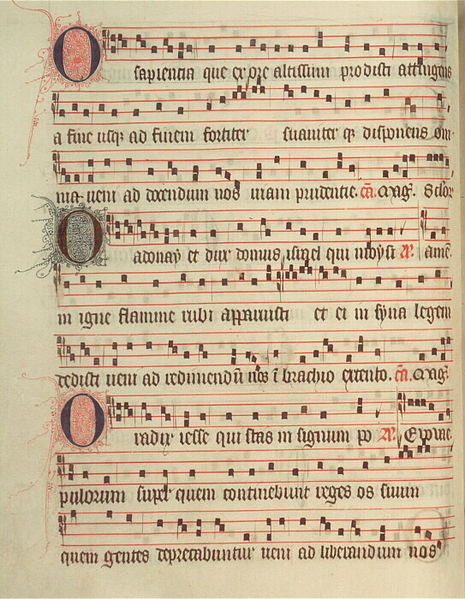
A friend sent me a card, saying he hoped O Come, O Come Emmanuel would be a topic for one of the remaining days of the Advent Calendar. This song, for him, evoked special memories of childhood.
That set me to thinking. It’s certainly not the first Christmas Carol most children learn. In fact [flash!], it isn’t a Christmas Carol at all. It’s a 100% Advent hymn whose text lays out a complete statement of the Advent narrative in progressive verses. Depending on which hymnal you use, you’ll even find the appropriate dates between December 17 and December 23 tagged to each verse.
As we know, our popular culture isn’t well-tuned to Advent, so in modern times, O Come, O Come Emmanuel is perceived as a Christmas Carol, and one of the most deeply moving!
The hymn is known popularly by its opening words: Veni, veni Emmanuel. Veni, in fact, is the imperative, or command, form of the Latin verb “to come” (venire). Yes, it’s the same verb that stands at the root of “Advent.” The beguiling melody is an old plainsong or chant. That’s what gives it the antique flavor to our modern ears.
But the real story of O Come, O Come Emmanuel lies in the text. The words are old, maybe as old as the 8th century. And they are actually a collection of words – sets of sentences that were read or sung before the reading of something else. This kind of added-in “pre-text” was called an antiphon (anti+phon).
I smile when I remember struggling to understand the word “antiphon” in my first college music history class. I’m sure I got it wrong on the test! But once I attended a service where the entire liturgy was chanted, rather than read, it all made perfect sense. Our understanding changes, doesn’t it, when we realize that an “ancient form” in church tradition was once a brand new way of worshipping God.
Each of the seven verses in O Come, O Come Emmanuel begins with the exclamation “O,” so they are known as the “O Antiphons.” Even more wonderfully, the antiphons present the prophetic names for Christ taken from the Book of Isaiah.
| Dec. 17 | O Sapientia (O Wisdom) |
| Dec. 18 | O Adonai (Hebrew name for God, usually translated “Lord”) |
| Dec. 19 | O Radix Jesse (O Wheel of Jesse) |
| Dec. 20 | O Clavis David (O Key of David) |
| Dec. 21 | O Oriens (O Light of the East) |
| Dec. 22 | O Rex Gentiem (O King of the Gentiles) |
| Dec. 23 | O Emmanuel (O Emmanuel) |
There’s one more surprise: the first letters of those prophetic names in Latin make an acronym: SARCORE. If you read that SARCORE backwards, you get ero cras. And that, in Latin, means “Tomorrow I come” or “Tomorrow I shall be.” Well, there you have it!
The credit for turning all of this into a hymn goes to John Mason Neale (1818-1866) an English minister and translator who was particularly devoted to traditional texts from Latin, Greek, and German. His scholarly interests mirrored an interest in old church music that blossomed in the 19th century. You might say that “retro” was in!
But it took a lot of work for someone like Neale to dig these things out, make translations, and find an appropriate way to harmonize the ancient tunes. Today, we can click to find ancient manuscripts pop right up on our computers, and click again to hear dozens of beautiful performances of the old tunes right on YouTube. Can you imagine what Neal would say to find O Come O Come Emmanuel spread across the Internet? I think he’d be pleased.
Enjoy these tender and worshipful renditions of O Come, O Come Emmanuel.



